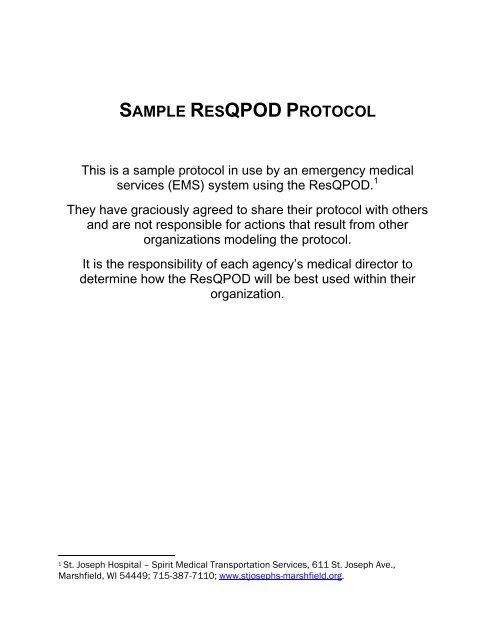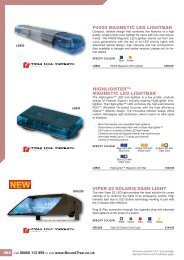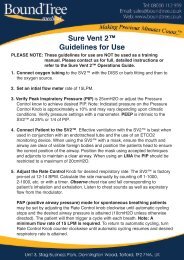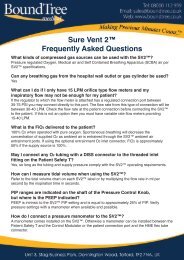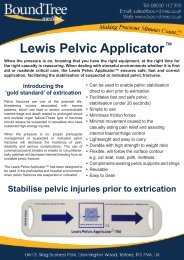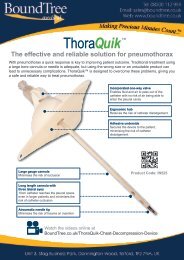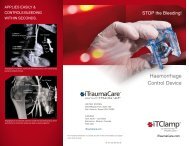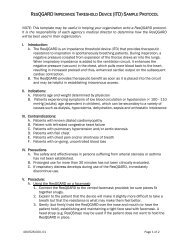SAMPLE RESQPOD PROTOCOL - Bound Tree Medical
SAMPLE RESQPOD PROTOCOL - Bound Tree Medical
SAMPLE RESQPOD PROTOCOL - Bound Tree Medical
You also want an ePaper? Increase the reach of your titles
YUMPU automatically turns print PDFs into web optimized ePapers that Google loves.
<strong>SAMPLE</strong> <strong>RESQPOD</strong> <strong>PROTOCOL</strong><br />
This is a sample protocol in use by an emergency medical<br />
services (EMS) system using the ResQPOD. 1<br />
They have graciously agreed to share their protocol with others<br />
and are not responsible for actions that result from other<br />
organizations modeling the protocol.<br />
It is the responsibility of each agency’s medical director to<br />
determine how the ResQPOD will be best used within their<br />
organization.<br />
1 St. Joseph Hospital – Spirit <strong>Medical</strong> Transportation Services, 611 St. Joseph Ave.,<br />
Marshfield, WI 54449; 715-387-7110; www.stjosephs-marshfield.org.
SPIRIT OF MARSHFIELD MEDICAL TRANSPORTATION SERVICE<br />
MEDICAL <strong>PROTOCOL</strong>S<br />
SUBJECT PAGE<br />
ResQPOD <strong>PROTOCOL</strong> 1 OF 2<br />
EFFECTIVE DATE DATE OF REVIEW AND<br />
SIGNATURE<br />
July 22, 2007<br />
I. ResQPOD Circulatory Enhancer:<br />
A. Conventional CPR provides 15% of normal blood flow to the heart and blood flow to the<br />
brain is 25% of normal. Current survival rates average 5%.<br />
B. The ResQPOD is an impedance threshold device that prevents unnecessary air from<br />
entering the chest during the decompression phase of CPR. When air is prevented from<br />
rushing into the lungs as the chest wall recoils, the vacuum (negative pressure) in the<br />
thorax pulls more blood back to the heart, resulting in a:<br />
1. Doubling of blood flow to the heart.<br />
2. 50% increase in blood flow to the brain.<br />
3. Doubling of systolic blood pressure.<br />
II. Indications:<br />
A. Cardiopulmonary arrest 12 years and older (medical etiology)<br />
III. Contraindications:<br />
A. Patients under 12 years of age<br />
B. Cardiopulmonary arrest related to trauma<br />
IV. Procedure:<br />
A. Confirm absence of pulse and begin CPR immediately. Assure that chest wall recoils<br />
completely after each compression.<br />
B. Using the ResQPOD on a facemask:<br />
1. Connect ResQPOD to the facemask.<br />
2. Connect ventilation source (BVM) to top of ResQPOD. If utilizing a mask without a<br />
bag, connect a mouthpiece.<br />
3. Establish and maintain a tight face seal with mask throughout chest compressions.<br />
Use a two-handed technique or head strap.<br />
4. Do not use the ResQPOD’s timing lights during CPR utilizing a facemask for<br />
ventilation.<br />
5. Perform ACLS interventions as appropriate.<br />
6. Prepare for endotracheal intubation.
SUBJECT EFFECTIVE DATE PAGE<br />
ResQPOD Protocol July 22, 2007 2 OF 2<br />
C. Using the ResQPOD on an endotracheal tube or Combitube:<br />
1. Endotracheal intubation is the preferred method of managing the airway when using<br />
the ResQPOD.<br />
2. Place endotracheal tube or Combitube and confirm placement. Secure the tube with<br />
a Comfit for adults and per Pediatric Endotracheal Tube Securing Protocol.<br />
3. Move the ResQPOD from the facemask to the advanced airway and turn on timing<br />
assist lights (remove clear tab).<br />
4. Continue CPR with minimal interruptions:<br />
a. Provide continuous (no pauses) chest compressions (approximately 10 per light<br />
flash) and ventilate asynchronously over 1 second when light flashes (10/min).<br />
5. Perform ACLS interventions as appropriate.<br />
6. If a pulse is obtained, remove the ResQPOD and assist ventilations as needed.<br />
V. Special Notes:<br />
A. Always place ETCO2 detector between the ResQPOD and ventilation source.<br />
B. Administer endotracheal medications directly into endotracheal tube.<br />
C. Do not interrupt CPR unless absolutely necessary.<br />
D. If a pulse returns, discontinue CPR and the ResQPOD. If the patient rearrests, resume<br />
CPR with the ResQPOD.<br />
E. Do not delay compressions if the ResQPOD is not readily available.<br />
APPROVED BY:<br />
Steven H. Mickel, M.D. Date<br />
<strong>Medical</strong> Director, Spirit of Marshfield <strong>Medical</strong> Transportation Service<br />
49-0458-000,01


